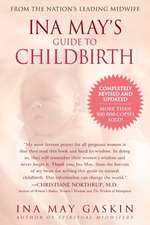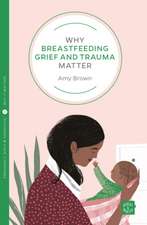Miscarriage, Medicine & Miracles: Everything You Need to Know about Miscarriage
Autor Bruce K. Young, Amy Zavattoen Limba Engleză Paperback – 31 mar 2009
From one of the foremost doctors in the field and a journalist who has experienced multiple miscarriages herself comes an accessible, encouraging, and complete guide to both the causes and, more important, the prevention of miscarriage.
Though one in four American women will lose her pregnancy, with the right pre-pregnancy evaluation and ongoing care, for many women miscarriage can be prevented. During forty years of practice, Dr. Bruce Young has treated hundreds of women who experienced this heartbreaking loss and helped them bring babies to term. Now he has teamed up with one of his patients, Amy Zavatto, to write this compassionate guide that combines medical facts with insights from both the patient’s and doctor’s viewpoints. Including real-life case studies, Dr. Young provides in-depth answers to the questions: Why did this happen to me? and What can I do to prevent it next time?
Providing the most up-to-date information on physical and mental health, nutrition, and technology, here is a proactive tool and comforting resource—from an expert with real-life reasons to give every woman hope for a successful pregnancy.
Preț: 118.73 lei
Nou
Puncte Express: 178
Preț estimativ în valută:
22.72€ • 24.29$ • 18.94£
22.72€ • 24.29$ • 18.94£
Carte disponibilă
Livrare economică 27 martie-10 aprilie
Preluare comenzi: 021 569.72.76
Specificații
ISBN-13: 9780553384857
ISBN-10: 0553384856
Pagini: 334
Dimensiuni: 208 x 132 x 20 mm
Greutate: 0.39 kg
Editura: Bantam
ISBN-10: 0553384856
Pagini: 334
Dimensiuni: 208 x 132 x 20 mm
Greutate: 0.39 kg
Editura: Bantam
Notă biografică
Bruce Young, MD., is internationally known as a leader and innovator in obstetrics and gynecology. He developed the first obstetrical intensive care unit and founded the Division of Maternal and Fetal Medicine at NYU Medical Center. He is the Silverman Professor of Obstetrics and Gynecology at NYU Medical School and is listed among America’s Top Doctors and in New York magazine’s Best Doctors 2008.
Amy Zavatto is a writer in New York City. Her work appears on Planned Parenthood’s Teen Wire website, as well as in New York magazine, Food & Wine, and Plenty.
From the Hardcover edition.
Amy Zavatto is a writer in New York City. Her work appears on Planned Parenthood’s Teen Wire website, as well as in New York magazine, Food & Wine, and Plenty.
From the Hardcover edition.
Extras
Chapter One
Preparing for Pregnancy: Understanding Your Body
NEWLYWEDS DIANA AND GREG STARTED TO THINK ABOUT having children within the first year they tied the knot. Now 25, Diana had been my patient since she was a teenager. At her routine visit six months before, I congratulated her on her recent marriage and her new job as a fund-raiser for the university she’d attended as an undergrad. I suggested that she come in for a pre-pregnancy session and bring along her husband, Greg, an outgoing and friendly newspaper writer, to discuss pregnancy.
When I met Diana ten years ago, her mother had brought her to my office. She was 15 and had been complaining of abdominal pain, which was getting worse and worse. At first, she told me, the pain came and went, although it was sometimes severe, but lately it was nearly continuous and she could not function at all. That day in my office she said the pain was across her lower abdomen and came in waves, but was constant and worse on the right side. It had gotten so bad it was affecting not just her after-school soccer, but her academic work as well. Understandably, both Diana and her mom were anxious about this frightening problem.
I examined Diana and found her abdomen to be very tender. I did a sonogram, which showed me that she had an ovarian cyst, causing a twisted right ovary—immediate surgery was necessary to save her ovary. I performed laparoscopic surgery, removed the cyst, and was able to untwist the ovary and save it, preserving her fertility.
laparoscopic surgery
Considered a minimally invasive procedure, laparoscopic surgery is performed by making several small incisions in the abdomen, usually one-half to one centimeter in length. An incision is made through the navel (although the incision may also be made just below the navel, I like to make it through the navel so the scar can’t be seen). A thin, long tube called a lap- aroscope is inserted through the incision into the patient. A camera is attached to the outside of the laparoscope, enabling the surgeon to see inside the patient by viewing an image on a TV screen transmitted by the camera. Tiny instruments are then inserted through secondary incisions to perform the surgery.
Now, a decade later, Diana was ready to put that fertility to use. She and Greg were planning pregnancy in about four months, after she finished working on a particularly stressful fund-raiser for the university’s capital endowment. I reviewed each of their medical histories and asked about their families to be sure that there were no hereditary problems or increased risk for miscarriage.
I examined Diana again and confirmed that there were no new findings and that she remained physically well. There was no residual scarring from her previous surgery; in fact, there were no visible scars from the laparoscopic surgery. Her fertility was not affected and she was in great shape to get pregnant.
Still, even with a clean bill of health there were some preliminary steps to be taken. I explained genetic screening to the couple and offered them our panel of blood tests for genetic diagnosis, best to be done at this time. I gave them my printed information for pregnant women, which contains answers to the most common questions and recommendations for nutrition and exercise, and describes normal changes in pregnancy. I began Diana on prenatal vitamins to be sure she had high levels in her body before she was pregnant. I explained the normal changes in pregnancy, what to expect, and what was not normal. I answered all the questions she and Greg had. Then I sent Diana for the standard blood tests for prenatal screening.
All Diana’s tests were normal. She and Greg followed my advice about stopping the birth control pill and switched to condoms until they were ready to try for pregnancy. Five months later, they conceived. The following nine months were uneventful except at the very end, when labor started. Diana was at work, going over some photos of an event for a news release she’d just finished. She ignored the contractions, approved the final shot for the piece—and then realized she was in the middle of her own newsworthy story.
She quickly called me, Greg, and then a car service. Her water broke as she came through the front door of NYU Medical Center where Greg was waiting. I met them on the elevator, and I whisked her into a delivery room.While Greg was changing to join us, Diana began to push. Three more pushes and I gave Diana and Greg the news they’d been waiting for—an 8 lb 4 oz boy named Stephen.
How Do You Become Pregnant?
I reviewed birth control methods with Diana and Greg. I advised her to stop the birth control pill she’d been using for three months before trying to conceive and switch to condoms or diaphragm to avoid any possible increased risk of miscarriage.
birth control and miscarriage
There is thought to be an increased risk of miscarriage with pregnancy right after stopping the pill. The reasons are possibly slow re-growth of the lining of the womb so that it is not ready to support a pregnancy, and irregular return of ovulation, which may not synchronize with the growth of the lining of the womb. Both of those problems may prevent normal implantation (attachment of the fertilized egg to the wall of the uterus) and inadequate development of the placenta leading to miscarriage.
Of course, you don’t need to get “the talk” from me, but you’d be surprised at how even the most well-educated, well-informed people can still be a little bit in the dark on how, step-by-step, pregnancy occurs. Even if you’ve got the procedure down pat, it is truly an amazing occurrence and one of the phenomenal things a woman’s body can do.
The uterus consists of the cervix, which is attached to the top of the vagina, and the corpus or “body.” The cervix allows fluid to leave the uterus and enter the vagina, as in menstruation, or fluid from the vagina to enter the uterus, such as seminal fluid, which carries the sperm into the uterus for fertilization and pregnancy. The cervix is the “mouth” of the uterus (or womb) and the “body” is the upper part, which is where the pregnancy usually forms.
cervix
The part of the uterus (womb) that protrudes into the top of the vagina and has an opening into the uterus. It is often referred to as the mouth of the womb.
uterus
The female reproductive organ to which the fallopian tubes and cervix are attached. Also called the womb, it carries the pregnancy.
Fertilization occurs when the sperm enter the uterus and then swim up to meet the egg, which was released by one of the two ovaries. This meeting usually happens in the oviduct (fallopian tube) or “tube,” which sweeps up the egg and moves it toward the uterus after it is released from the ovary (ovulation). After sperm and egg meet (fertilization), the fertilized egg continues down the tube and attaches to the wall of the uterus (implantation), where it forms the placenta (afterbirth) and the embryo that becomes the baby.
placenta
The afterbirth, which is an organ of fetal origin that grows into the mother’s uterine wall for its blood supply and provides oxygen and nutrition to the fetus while removing fetal carbon dioxide and products of fetal metabolism.
fallopian tubes
Also called oviducts, these are the flexible, moving structures that carry the released eggs, or ova, from the ovaries to the uterus.
ovulation
The midway point during the menstrual cycle when a mature egg, or ovum, is released from an ovary and sent down the fallopian tube (oviduct) toward the uterus to await fertilization. If fertilization does not occur, the egg will be absorbed. Although most menstrual cycles are based on a 28-day calendar, many women have shorter or longer cycles, and thus ovulation can occur earlier or later than the standard midpoint of day 14 to 16. Every month the cycle is started by hormones that stimulate up to 20 of the 300,000 or so eggs stored in your ovaries. Usually, only one egg develops enough to respond to the hormonal trigger to ovulate, while the others break down and get absorbed. Once the egg and sperm meet in the oviduct and unite in fertilization, the embryo begins to form as it journeys to the uterus. That trip takes about three days and then the embryo attaches itself to the wall of the uterus. This is implantation, as the embryo buries itself in the lining tissues of the uterus and is nourished there.
implantation
A process by which the embryo buries itself in the lining of the uterus, the endometrium.
Pre-Pregnancy Testing
Earlier in this chapter, I briefly mentioned that there were tests I advised Diana to undergo before getting pregnant, as well as recommendations I gave her for staying pregnant for the full nine months. Let’s take a closer look at those now.
Preparing for Pregnancy: Understanding Your Body
NEWLYWEDS DIANA AND GREG STARTED TO THINK ABOUT having children within the first year they tied the knot. Now 25, Diana had been my patient since she was a teenager. At her routine visit six months before, I congratulated her on her recent marriage and her new job as a fund-raiser for the university she’d attended as an undergrad. I suggested that she come in for a pre-pregnancy session and bring along her husband, Greg, an outgoing and friendly newspaper writer, to discuss pregnancy.
When I met Diana ten years ago, her mother had brought her to my office. She was 15 and had been complaining of abdominal pain, which was getting worse and worse. At first, she told me, the pain came and went, although it was sometimes severe, but lately it was nearly continuous and she could not function at all. That day in my office she said the pain was across her lower abdomen and came in waves, but was constant and worse on the right side. It had gotten so bad it was affecting not just her after-school soccer, but her academic work as well. Understandably, both Diana and her mom were anxious about this frightening problem.
I examined Diana and found her abdomen to be very tender. I did a sonogram, which showed me that she had an ovarian cyst, causing a twisted right ovary—immediate surgery was necessary to save her ovary. I performed laparoscopic surgery, removed the cyst, and was able to untwist the ovary and save it, preserving her fertility.
laparoscopic surgery
Considered a minimally invasive procedure, laparoscopic surgery is performed by making several small incisions in the abdomen, usually one-half to one centimeter in length. An incision is made through the navel (although the incision may also be made just below the navel, I like to make it through the navel so the scar can’t be seen). A thin, long tube called a lap- aroscope is inserted through the incision into the patient. A camera is attached to the outside of the laparoscope, enabling the surgeon to see inside the patient by viewing an image on a TV screen transmitted by the camera. Tiny instruments are then inserted through secondary incisions to perform the surgery.
Now, a decade later, Diana was ready to put that fertility to use. She and Greg were planning pregnancy in about four months, after she finished working on a particularly stressful fund-raiser for the university’s capital endowment. I reviewed each of their medical histories and asked about their families to be sure that there were no hereditary problems or increased risk for miscarriage.
I examined Diana again and confirmed that there were no new findings and that she remained physically well. There was no residual scarring from her previous surgery; in fact, there were no visible scars from the laparoscopic surgery. Her fertility was not affected and she was in great shape to get pregnant.
Still, even with a clean bill of health there were some preliminary steps to be taken. I explained genetic screening to the couple and offered them our panel of blood tests for genetic diagnosis, best to be done at this time. I gave them my printed information for pregnant women, which contains answers to the most common questions and recommendations for nutrition and exercise, and describes normal changes in pregnancy. I began Diana on prenatal vitamins to be sure she had high levels in her body before she was pregnant. I explained the normal changes in pregnancy, what to expect, and what was not normal. I answered all the questions she and Greg had. Then I sent Diana for the standard blood tests for prenatal screening.
All Diana’s tests were normal. She and Greg followed my advice about stopping the birth control pill and switched to condoms until they were ready to try for pregnancy. Five months later, they conceived. The following nine months were uneventful except at the very end, when labor started. Diana was at work, going over some photos of an event for a news release she’d just finished. She ignored the contractions, approved the final shot for the piece—and then realized she was in the middle of her own newsworthy story.
She quickly called me, Greg, and then a car service. Her water broke as she came through the front door of NYU Medical Center where Greg was waiting. I met them on the elevator, and I whisked her into a delivery room.While Greg was changing to join us, Diana began to push. Three more pushes and I gave Diana and Greg the news they’d been waiting for—an 8 lb 4 oz boy named Stephen.
How Do You Become Pregnant?
I reviewed birth control methods with Diana and Greg. I advised her to stop the birth control pill she’d been using for three months before trying to conceive and switch to condoms or diaphragm to avoid any possible increased risk of miscarriage.
birth control and miscarriage
There is thought to be an increased risk of miscarriage with pregnancy right after stopping the pill. The reasons are possibly slow re-growth of the lining of the womb so that it is not ready to support a pregnancy, and irregular return of ovulation, which may not synchronize with the growth of the lining of the womb. Both of those problems may prevent normal implantation (attachment of the fertilized egg to the wall of the uterus) and inadequate development of the placenta leading to miscarriage.
Of course, you don’t need to get “the talk” from me, but you’d be surprised at how even the most well-educated, well-informed people can still be a little bit in the dark on how, step-by-step, pregnancy occurs. Even if you’ve got the procedure down pat, it is truly an amazing occurrence and one of the phenomenal things a woman’s body can do.
The uterus consists of the cervix, which is attached to the top of the vagina, and the corpus or “body.” The cervix allows fluid to leave the uterus and enter the vagina, as in menstruation, or fluid from the vagina to enter the uterus, such as seminal fluid, which carries the sperm into the uterus for fertilization and pregnancy. The cervix is the “mouth” of the uterus (or womb) and the “body” is the upper part, which is where the pregnancy usually forms.
cervix
The part of the uterus (womb) that protrudes into the top of the vagina and has an opening into the uterus. It is often referred to as the mouth of the womb.
uterus
The female reproductive organ to which the fallopian tubes and cervix are attached. Also called the womb, it carries the pregnancy.
Fertilization occurs when the sperm enter the uterus and then swim up to meet the egg, which was released by one of the two ovaries. This meeting usually happens in the oviduct (fallopian tube) or “tube,” which sweeps up the egg and moves it toward the uterus after it is released from the ovary (ovulation). After sperm and egg meet (fertilization), the fertilized egg continues down the tube and attaches to the wall of the uterus (implantation), where it forms the placenta (afterbirth) and the embryo that becomes the baby.
placenta
The afterbirth, which is an organ of fetal origin that grows into the mother’s uterine wall for its blood supply and provides oxygen and nutrition to the fetus while removing fetal carbon dioxide and products of fetal metabolism.
fallopian tubes
Also called oviducts, these are the flexible, moving structures that carry the released eggs, or ova, from the ovaries to the uterus.
ovulation
The midway point during the menstrual cycle when a mature egg, or ovum, is released from an ovary and sent down the fallopian tube (oviduct) toward the uterus to await fertilization. If fertilization does not occur, the egg will be absorbed. Although most menstrual cycles are based on a 28-day calendar, many women have shorter or longer cycles, and thus ovulation can occur earlier or later than the standard midpoint of day 14 to 16. Every month the cycle is started by hormones that stimulate up to 20 of the 300,000 or so eggs stored in your ovaries. Usually, only one egg develops enough to respond to the hormonal trigger to ovulate, while the others break down and get absorbed. Once the egg and sperm meet in the oviduct and unite in fertilization, the embryo begins to form as it journeys to the uterus. That trip takes about three days and then the embryo attaches itself to the wall of the uterus. This is implantation, as the embryo buries itself in the lining tissues of the uterus and is nourished there.
implantation
A process by which the embryo buries itself in the lining of the uterus, the endometrium.
Pre-Pregnancy Testing
Earlier in this chapter, I briefly mentioned that there were tests I advised Diana to undergo before getting pregnant, as well as recommendations I gave her for staying pregnant for the full nine months. Let’s take a closer look at those now.
Recenzii
"Dr. Young and Amy Zavatto have produced the most comprehensive patient-directed book on the subject of miscarriage and pregnancy loss that that I have seen. It presents complete and scientifically sound information on the causes and prevention of recurrent miscarriage and does so in a fashion that does not require a medical education to understand….It will be an excellent guide for women and their partners who have experienced these problems."—Richard H. Schwarz, M.D., FACOG, FRCOG, Vice Chairman for Clinical Affairs, Department of Obstetrics and Gynecology, Maimonides Medical Center Professor of Obstetrics, Gynecology and Reproductive Science, Mt. Sinai School of Medicine
"This book deals with an issue that is not much talked about. It offers solutions in a down to earth manner that is easily accessible to everyone….I wish this book had been around when I was having the personal experience of multiple miscarriages."—Rebecca Lisa Shiffman, MD, Director of Obstetrics and Vicechair, Department of Obstetrics and Gynecology, New York Methodist Hospital
"Miscarriage is among the most common and most misunderstood aspects of all modern medicine. Dr Bruce Young, a pioneer and international leader in perinatal medicine, and Amy Zavatto, a patient who has experienced a miscarriage, have teamed up to write a comprehensive and compassionate analysis of this subject. All women who anticipate getting pregnant would benefit from this invaluable and unique text."—Frank A. Chervenak, M.D., Given Foundation Professor and Chairman, Department of Obstetrics and Gynecology, New York Weill Cornell Medical Center
"Comprehensive information on the causes and preventions of miscarriage."—Miami Herald
From the Hardcover edition.
"This book deals with an issue that is not much talked about. It offers solutions in a down to earth manner that is easily accessible to everyone….I wish this book had been around when I was having the personal experience of multiple miscarriages."—Rebecca Lisa Shiffman, MD, Director of Obstetrics and Vicechair, Department of Obstetrics and Gynecology, New York Methodist Hospital
"Miscarriage is among the most common and most misunderstood aspects of all modern medicine. Dr Bruce Young, a pioneer and international leader in perinatal medicine, and Amy Zavatto, a patient who has experienced a miscarriage, have teamed up to write a comprehensive and compassionate analysis of this subject. All women who anticipate getting pregnant would benefit from this invaluable and unique text."—Frank A. Chervenak, M.D., Given Foundation Professor and Chairman, Department of Obstetrics and Gynecology, New York Weill Cornell Medical Center
"Comprehensive information on the causes and preventions of miscarriage."—Miami Herald
From the Hardcover edition.

















